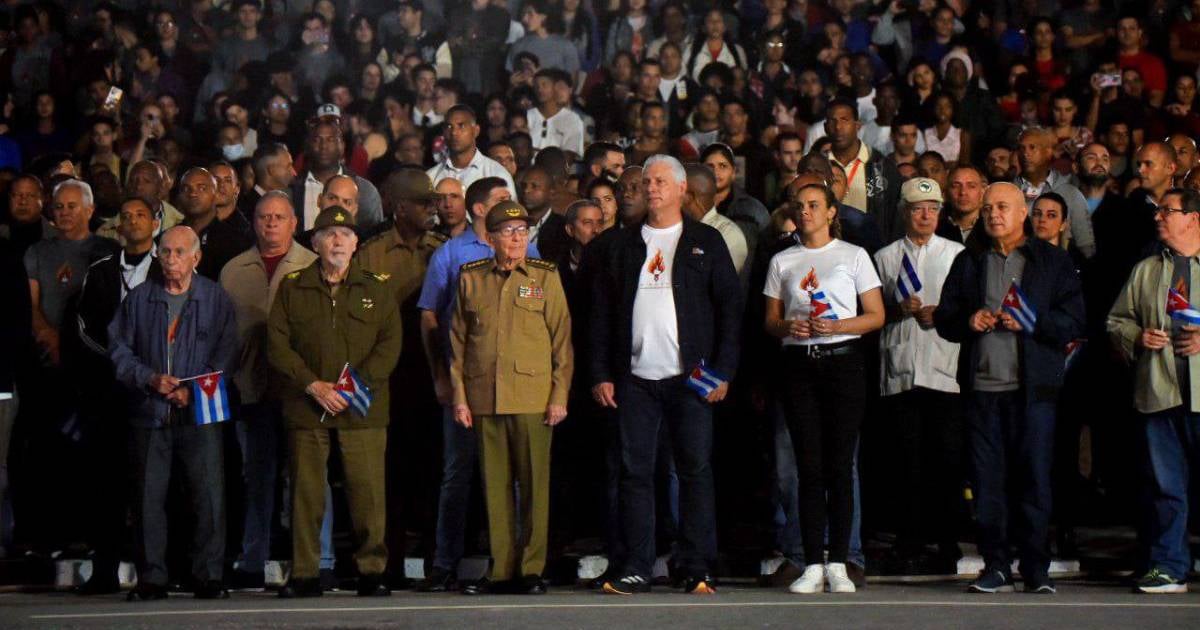
Related videos:
On the night of January 27th, in Havana, Army General Raúl Castro Ruz made a public reappearance at the traditional March of the Torches.
The event, which commemorates the 172nd anniversary of the birth of National Hero José Martí, also featured the participation of leader Miguel Díaz-Canel Bermúdez and historical figures such as commanders Ramiro Valdés Menéndez and José Ramón Machado Ventura.
Raúl Castro's presence appears to be part of a strategy by the regime to shore up Díaz-Canel's deteriorating image, as he faces a crisis of popularity amid growing social discontent due to food shortages, blackouts, repression, and the rise of extreme poverty in Cuba.
The march, which in the past attracted a significant crowd of young people, saw average participation this time, and the most visible faces in the media are those of aging leaders.
In a context of deep economic and social crisis, with sporadic protests and a massive exodus of young people and those of working age, Raúl Castro's figure seeks to convey an image of unity and strength within the government.
However, for many Cubans, his public appearance highlights the need to turn to a historic leader at a time when Díaz-Canel lacks sufficient popular support to lead on his own.
Other events where Raúl Castro recently appeared
In recent months, Raúl Castro has increased his public appearances, marking a shift from his reserved profile in previous years. This rise in visibility appears to respond to the need to project stability and leadership at a time of institutional fragility.
On December 19, 2024, he attended the Fourth Regular Session of the Parliament, where he surprised everyone by ordering the legislators to stand up and raise their fists in a gesture of unity.
This symbolic gesture, although perplexing for some, aimed to convey strength in the face of the challenges the country is facing. A few days later, he presided over a posthumous tribute to Commander Julio Camacho Aguilera, reaffirming his prominent role in high-profile ceremonies.
Last week, he oversaw the Strategic Exercise Bastion 2024, a key military event designed to reinforce the country's "invulnerability." Accompanied by Miguel Díaz-Canel and other government leaders, his presence at the start of the maneuvers emphasized his role in the military and political sphere.
In addition to his role in military and political events, Raúl Castro has sought to project a more approachable image to the public through visits to social institutions, such as a special school in December 2024, and by presenting official accolades to prominent figures.
Their participation in these events aims to reinforce the perception of continuity in the historical leadership of the Communist Party amidst a context of increasing discredit of the government.
Together, these appearances reinforce the narrative of control and stability of the regime during a critical period for Cuba, where social demands and the economic crisis pose increasing challenges to the regime.
Frequently Asked Questions about the Torch March and the Political Situation in Cuba
Why did Raúl Castro reappear at the March of the Torches?
Raúl Castro reappeared at the March of the Torches to support President Miguel Díaz-Canel, whose popularity is declining. Castro's presence aims to reinforce the image of unity and strength of the Cuban government at a time of economic and social crisis on the island.
What is the current situation of Miguel Díaz-Canel in Cuba?
Miguel Díaz-Canel is facing a crisis of popularity due to issues such as food shortages, blackouts, and repression. Social discontent is rising, and his leadership is increasingly being called into question, which has led the regime to turn to historical figures like Raúl Castro to bolster its image.
How has the Cuban population reacted to the March of the Torches?
The participation in the March of the Torches was moderate, reflecting the disillusionment of Cubans with the government. The event mainly showcased the faces of aging leaders, highlighting the lack of youth support and the growing discontent with the current situation in the country.
What is the Cuban government trying to convey with Raúl Castro's presence at public events?
The presence of Raúl Castro at public events aims to project an image of continuity and stability in the government. In a context of crisis, his symbolic figure is used to reinforce the image of the historical leadership of the Communist Party and to counteract popular discontent.
Filed under: